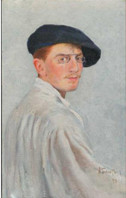
Society and culture: Works by Leon Bakst are presented at the exhibition, timed to the 150th anniversary of the artist, at the State Russian Museum
February 24, 2016 in the Benois Wing (the State Russian Museum, St. Petersburg) is opened the exhibition "Leon Bakst. 1866-1924".
Lev (Leon) Bakst - the world-famous painter and graphic artist, who made an invaluable contribution to Russian theater and decorative art of the era of his heyday. These are sets and costumes, performed on sketches by Léon Bakst, resulted in an unprecedented success of the legendary "Diaghilev seasons" - ballet and opera productions in Russia, France and other countries. The exhibition is dedicated to the 150th anniversary of the great master, showing about 100 paintings, graphic and theatrical decorative works from the collection of the State Russian Museum, the State Tretyakov Gallery and other museum collections.
Since the mid-1890s Lev Bakst is part of the circle of writers and artists, united around Sergei Diaghilev and Alexandre Benois, and later became one of the initiators of the society "The World of Art" - one of the most striking phenomena in Russian culture of the XIX and XX centuries. In the works of 1890-1900s - beautiful portraits and landscapes, book and magazine graphics samples and compositions relating to the manner of the ancient world, organically combined traditions of realistic art, clear plastic language of neo-classicism, elegance and bright line decorative of Art Nouveau.
A close interest in the heritage of antiquity, ancient and medieval East, most fully revealed in the end of stage works Bakst of the end 1900-1910s is associated with the "Diaghilev seasons" (registration ballets "Cleopatra", "Scheherazade," "Carnival", "Narcissus" "Daphnis and Chloe" and others). Costumes and scenery, marked the highest craftsmanship, had a tremendous influence on the development of theater art in the world, becoming a unique example of a combination of bold innovation and keen interest in the artistic traditions of the distant past.

